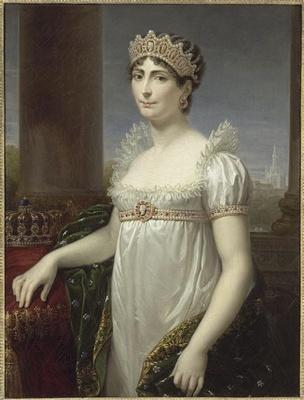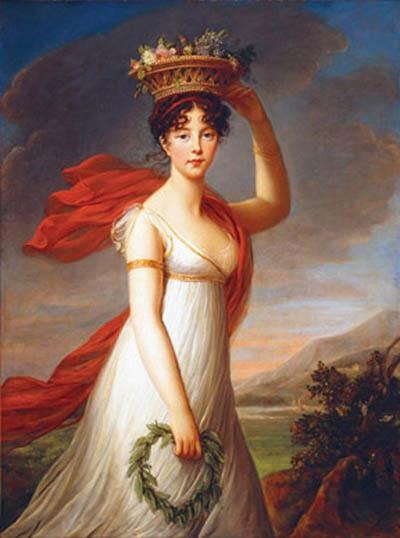Remember, I am to have a new Carriage hung as high as the Duttons', and blue spotted with silver; and I shall expect a new saddle horse, a suit of fine lace, and an infinite number of the most valuable Jewels. Diamonds such as never were seen, and Pearls, Rubies, Emeralds, and Beads out of number...
-Jane Austen, The Three Sisters
You’ve probably seen these coral necklaces dozens of times without noticing them. I have. These beautiful single string coral necklaces worn by Regency ladies escaped my attention until my friend and blogging partner on
Jane Austen Today, Laurel Ann of
Austenprose, sent me some spectacular images of this Regency fashion, such as the one of Lady Maria Hamilton, who died in 1814, unmarried. Coral has enjoyed a long and ancient tradition, first worn as a talisman and later for its color and beauty. One of my favorite drawings by Peter Paul Rubens depicts his son with a coral necklace. At the time coral was thought to protect the wearer.
Where does the tradition come from?
The tradition of giving children coral necklaces continued through the 19th century, as shown in this detail of a late 18th century John Hoppner painting of one of the Sackville girls. The gemstone was considered a guardian of sorts, protecting children from illnesses like stomachaches, fever, typhus, smallpox, and rickets. The mala beads were polished to a smooth sheen and matched in color. Bead sizes could be similar or gradated from small to larger stones that were strung in the center.
A rare collectable
Handmade jewellery created during the late Georgian Era in the Regency Style (1760-1837) is extremely hard to find today. As styles changed, the pieces were remade rather than tossed out or sold. Until the latter part of the 18th century, coral was harvested from the sea largely by dredging. Fine quality red coral came from the Mediterranean – Algeria, France, Italy, Morocco, Spain, Tunisia and the islands of Corsica, Sardinia and Sicily, with some saying that the best corals came off the coasts of Algeria and Tunisia. Eighteenth century coral was a rich warm red and is unavailable today. In fact, original antique jewellery made with dark red coral is so difficult to find that it has become a highly prized collectible.


Simple round necklaces, like the one worn by the Countess of Oxford, were popular and complimented low necklines, but chokers were also fashionable, like the Georgian Cannetille Sardinian red coral four strand necklace on the left. Coral is made up of the skeletal material built up by small animals that live in slow growing colonies in the sea.
Colors found in the Regency style range from vivid orange, red, and white, to salmon and pale pink (called angelskin coral). In jewelry making coral is either carved into beads, cameos, and other forms, or is left in its natural branch-like form and simply polished. (My mother had such a necklace, which I played with as a child.) The most sought after color (and the rarest) is a deep red, as in the necklace at left.
Coral manufacturing for the Regency style consisted primarily of filing beads of smoothed coral and stringing necklaces. Because coral consists of calcium carbonate, it is extremely sensitive to chemicals, perfumes, and body acids. Like pearls, the necklaces must be washed with a damp cloth (no detergents) and restrung periodically.
Many mystical and medicinal properties were attributed to coral, among them vitality, physical strength, stronger marital relationships, wealth, increased sensuality, and protection while out to sea. Coral was also used as a medicinal powder. Primitive physics believed that coral oxides mixed with honey made a person strong. Mix it with betel leaf and it made a potent cure for cough and heart disease. Coral powder is still a popular aphrodisiac in India today, which prompts avaricious collectors to dynamite coral reefs, putting fragile reefs in acute danger
In the detail of a 17th century drawing by Jacopo Vignali at left, one can easily see why this semi-precious stone was considered to have sensual qualities. The combination of the coral necklace and her full lips make the young woman look both fragile and seductive.
If you would like to accessorise with a coral piece in the Regency style, check out our Marianne Ring.
Vic Sanborn oversees two blogs: Jane Austen’s World and Jane Austen Today. Before 2006 she merely adored Jane Austen and read Pride and Prejudice faithfully every year. These days, she is immersed in reading and writing about the author’s life and the Regency era. Co-founder of her local (and very small) book group, Janeites on the James, she began her blogs as a way to share her research on the Regency era for her novel, which sits unpublished on a dusty shelf. In her working life, Vic provides resources and professional development for teachers and administrators of Virginia’s adult education and literacy programs. This article was written for Jane Austen’s World and is used here with permission.









1 comment
A coral necklace was still a suitable gift for a child into the 20th century. In “Ballet Shoes”, one of my very favorite childhood books, the three orphan sisters were each given a necklace by their absent guardian, and the youngest girl, Posy, got a coral necklace.
Elaine Murray
Leave a comment
This site is protected by hCaptcha and the hCaptcha Privacy Policy and Terms of Service apply.